Covering more than 70% of the Earth’s surface*, the ocean is home to an abundance of marine life. From animal species to plant life, from salt water to fresh water, the ocean is full of wonders - many of which are yet to be discovered. But there is one unwelcome resident.
In 2017 alone, the Ocean Conservancy** collected over 20 million pounds of trash from the ocean, enough to equal the weight of 812 cruise ship anchors. Ocean trash can have detrimental effects on both marine life and water sources, but together we can help to reduce this waste and protect our ocean and its inhabitants.
Keep reading to find out the top 10 sources of ocean trash in the United States** and our top tips to tackle them:

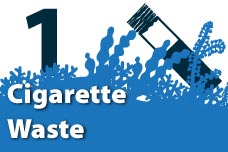
According to the U.S. Environmental Protection Agency (EPA), cigarette butts are the most frequently littered item of waste, so it’s no surprise that they take the top spot for ocean trash. When carelessly discarded, cigarette waste is often carried into water drainage systems, where it eventually finds its way into rivers, lakes and our waterways.
Cigarette waste is not just unsightly; it contains toxic chemicals which can cause water contamination and harm to wildlife and marine life. Cigarette butts do not readily or easily biodegrade and so will remain in our oceans until they are actively collected.
Placing dedicated cigarette ash receptacles in public areas and workplaces is a simple yet effective way to help decrease cigarette butt littering and reduce ocean waste. Once collected, these cigarette butts can be recycled by dedicated companies such as TerraCycle or repurposed to keep them away from landfill and out of our oceans.
Find out more about how to reduce cigarette butt littering.
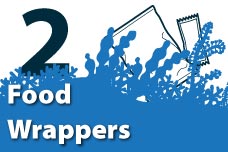
Packaging for candy, chips, granola bars and other types of convenience food make up the second largest volume of trash collected from American waterways.
Food wrappers come in the form of many different materials, from difficult to recycle polymers to recyclable paper and aluminum, so you should always check the label before discarding wrappers into a trash can or recycling container.
The frequency of dropped litter increases with the distance between trash cans, so make sure there are plenty of waste receptacles available for use to save food wrappers from entering our oceans.
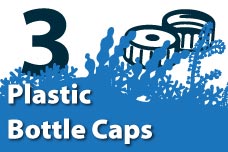
Like cigarette butts, plastic bottle caps often find their way into the oceans through drainage systems when littered.
There are many discrepancies about how and if plastic bottle caps can be recycled. Some waste contractors recommend leaving bottle caps attached to plastic bottles whilst others recommend separation, so always ensure you check your local recycling rules before discarding.
If your local recycling facility does not accept plastic lids for recycling, don’t worry!
Some charities and non-profit organizations collect plastic caps and repurpose them into different objects. Washed Ashore Art collect caps amongst other common ocean waste and turn them into artforms, to raise awareness on the effects of ocean pollution.
Our recycling containers can be personalized and adapted to collect any waste stream, so you can easily collect plastic caps to be donated to similar organizations.
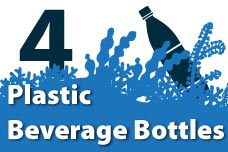
Single-use plastics such as plastic bottles are an easily avoidable waste stream which often ends up as trash in the ocean. Plastic bottles do not easily biodegrade, meaning that if sent to landfill or discarded into the sea, they will remain there for hundreds of years before decomposing.
Often made from PET (#1) polymers, plastic bottles can be widely recycled into new products such as carpets, furniture and tote bags. Recycling plastic bottles uses less energy than is needed to create new virgin plastics, so these should be placed into a plastic bottle recycling container wherever possible.
To find out more about plastic resin identification codes, view our easy guide to plastic recycling symbols.
If you reside in one of the ten U.S. states which currently hold container deposit laws, then it is ideal to ensure beverage container collection is encouraged wherever possible. These bottle bills help to incentivize recycling, resulting in reduced littering rates and waste diversion costs, whilst saving our environment from pollution.
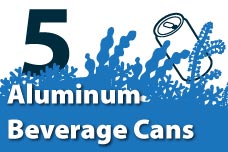
Aluminum cans are 100% recyclable - so much so that 75% of all aluminum produced in the U.S is still in use today!
Recycling aluminum can help to conserve natural resources, save energy and benefit the environment all-in-one. To encourage recycling and decrease the risk of aluminum cans becoming marine debris, drinks can recycle containers should be sited in areas of high-footfall within workplaces, shopping malls, leisure environments and city centers.
State Bottle Bills also cover the collection of aluminum drinks cans, where each can returned for recycling receives a small refund. We provided the Californian City of El Monte with dual recycling containers for the collection of plastic bottles and aluminum drinks cans, to help adhere to their state bottle bill and improve container recycling.
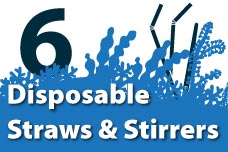
Despite being made from widely recyclable polypropylene (#5 PP), plastic straws are not generally accepted in recycling programs. Size constraints make plastic straws difficult to recycle, often resulting in waste contamination if placed into a recycling bin.
Plastic straws float when in water and do not biodegrade, so will remain in landfill and our oceans until actively removed.
A great way to minimize consumption of single-use straws and stirrers is to simply avoid them. Eco-alternatives such as compostable straws can be used to sip your soda without the risk of environmental harm, whilst metal straws can be rinsed and re-used as many times as you like.
Find out more about how you can help to minimize plastic waste.
Better still, why not simply forgo the straw altogether?
Seattle teamed up with Lonely Whale in 2017 to launch their Strawless in Seattle Campaign, in which a temporary straw ban saw 2.3 million straws permanently removed from the city over just one month. Since then, many cities including Seattle have implemented permanent bans on single-use plastic, prohibiting the distribution of plastic straws, stirrers and utensils within restaurants and food vendors.
These methods can help to reduce the amount of single-use plastics in our environment to help stop the effects of plastic pollution.
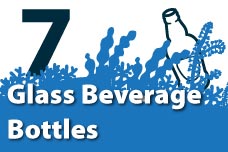
Glass can be fully recycled, yet only one-third of all glass containers are currently recycled in the U.S.
Glass does not decompose but can be re-used and recycled multiple times without losing purity or quality, so should be placed into glass recycling bins wherever possible.
Recycling glass also helps to save resources. The glass manufacturing process results in the emission of greenhouse gases such as carbon dioxide, which has a negative impact when released into the atmosphere.
Recycling glass helps to reduce this impact, contributing to a more circular economy and benefiting both the environment and our oceans.
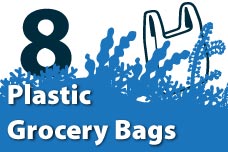
The International Cleanup saw enough plastic grocery bags collected from the ocean to sew the sails of 5,461 boats, but there is still more we can do to help.
Plastic bags are not often accepted in curbside recycling programs, but that doesn’t mean they aren’t recyclable. Often made from #2 or #4 polymers, plastic bags can be successfully reprocessed into new plastic bags and recycled to create new polymers at designated recycling centers.
Find out more about how to reduce plastic bag waste.
Many grocery stores are now offering take-back schemes, in which you can deposit your used bags into plastic film recycling bins to be given a new lease of life. We collaborated with Food Lion to help create a recycling bank for their customers and the community, featuring dedicated containers for plastic bags to encourage recycling and keep them out of landfill.
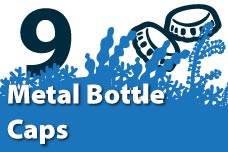
Metal bottle caps are commonly found on recyclable glass jars and containers, which are often sent to be recycled at mixed recycling facilities. Due to their size, these metal caps are often lost during the sorting process, meaning they aren’t always recycled.
When separated from their glass counterparts, metal caps are highly desirable at independent metal recycling centers. Some metal lids feature a non-metallic coating, however this is typically burnt off at the melting stage of the process, allowing them to successfully be recycled and recirculated into the economy.
Collect used caps within dedicated metal recycling bins before taking them to recovery centers to prevent unnecessary waste entering the wider environment.
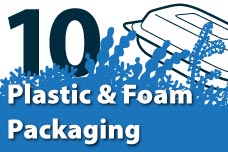
Trash from food packaging such as foam take-out containers and plastic tubs often find their way into the waterways where they become marine debris and can damage marine life. These containers do not biodegrade and so will contribute to unsightly, harmful ocean litter until removed.
Contrary to popular belief, expanded polystyrene foam containers are made from a recyclable #6 thermoplastic. These containers are not widely accepted within curbside recycling schemes but are accepted for recycling at designated foam recycling centers. Find your nearest foam recycling facility for drop-off, here.
As for plastic packaging containers, why not repurpose them? Plastic pots and tubs can be re-used for a variety of applications, be it to store leftovers, hold keepsakes or to take your lunch to work the next day. These ideas can help to reduce the levels of trash in our ocean, thereby minimizing plastic pollution.
For more information on how you can help to tackle ocean trash and minimize plastic waste, please connect with us via LiveChat today!

*https://oceanservice.noaa.gov/facts/oceanwater.html
**2017 International Coastal Cleanup Results – Top items collected in the U.S.
https://oceanconservancy.org/wp-content/uploads/2018/07/Building-A-Clean-Swell.pdf




